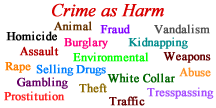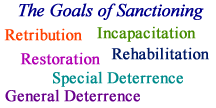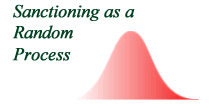Sanctioning is Asymmetric
Sanctioning is Asymmetric
There has not been very much discussion of the asymmetric nature of sanctioning with respect to the propensity for crime. At some level, the subject seems almost trivial in nature. It seems obvious that societies only sanction the most harmful behaviors. The sanctioning process often involves harm to the person being sanctioned, and the amount of harm inflicted by the sanction should be weighed against the level of harm done by the individual. This concept is found in some of the earliest criminal codes and is present in the idea of an “eye for an eye.” The rule is to only inflict as much harm as was caused. The rule is not “two eyes for an eye.” Therefore, the sanctioning process only involves people with a high propensity for crime (harming others).

Crime as Harm
The process of sanctioning can be examined from a number of perspectives. It is helpful to begin with an examination of the nature of crime. Crimes tend to be behaviors that are seen to cause harm or potential harm to others. As the likelihood of harm increases, the likelihood of sanctioning increases as well.

The Goals of Sanctioning
One way to examine the process of sanctioning is to examine the goals of sanctioning. There are six generally accepted goals of sanctioning, 1) retribution, 2) general deterrence, 3) restoration, 4) special deterrence 5) incapacitation, and 6) rehabilitation. The likelihood of sanctioning a person with a high criminal propensity is higher when the goal is incapacitation, rehabilitation, or special deterrence. The goal of incapacitation is to remove the most dangerous individuals from society. The most dangerous are those with a high criminal propensity. The goal of rehabilitation and special deterrence is to change the minds of those who are most likely to commit a new crime. Although not all goals of sanctioning are related to the asymmetric reduction of criminal propensity, some are.

Sanctioning as a Random Process
One can also examine sanctioning as a random process. Only about 10% of all crimes are ever cleared. That is, 90% of crimes are not connected to a criminal who is prosecuted. Therefore, there is a large element of randomness in the sanctioning process. A person’s likelihood of being sanctioned increases with a person’s likelihood of committing a crime. This is illustrated by the gradient on the left. People with a higher criminal propensity on the right of the distribution are more likely to be sanctioned because they are more likely to commit a crime and are more likely to be caught.
